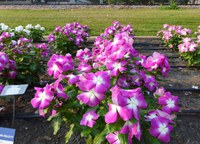Dakota Gardener: Make Your Flower Garden the Envy of the Neighborhood
(Click an image below to view a high-resolution image that can be downloaded)
By Esther E. McGinnis, Horticulturist
NDSU Extension
Barb Laschkewitsch is a busy woman. As the trial garden manager for the North Dakota State University (NDSU) Horticulture Research and Demonstration Garden, she is busy sowing thousands of annual flowers in a 1950s era campus greenhouse.
After the danger of frost has passed, the colorful flowering plants will grace the campus garden this summer on the corner of 12th Avenue and 18th Street North in Fargo.
This garden is more than just a pretty place to view flowers. Laschkewitsch is engaging in research to benefit home gardeners and the retail industry. She sows and transplants more than 200 cultivars as part of a research project to identify which annuals will thrive in the region’s soils and summer climate.
Laschkewitsch says, “Our research results are meant to help home gardeners select top performing annual flowers when they visit their garden centers in the spring. More importantly, we want to help consumers avoid wasting money on cultivars that do poorly in our region.”
The research process begins early. Lisianthus, a notoriously difficult-to-grow cut flower, is seeded at the end of December. Small-seeded crops such as begonia and geranium are sowed in mid-January and early February, respectively. Petunias and snapdragons are easier to grow and are planted in March. Finally, quick growing annuals such as marigold and zinnia are sowed in April.
NDSU Extension Master Gardeners assist in transplanting the annuals to the garden in early June. After an establishment period, Laschkewitsch then evaluates the plants for bloom, uniformity and vigor in both early August and September.
At the end of the season, she releases an expansive trial report and recommends the top performers from that year. With 2021’s heat and drought, warm-season genera such as vinca (Catharanthus) and Celosia had multiple cultivars that were ranked as top performers.
Vinca does well in hot, dry locations and several Mega Bloom series cultivars were the stars of the mid-summer garden. The Celosia argentea cultivar, Asian Garden, with its pink, wheat-like spikes is a very reliable performer in the campus gardens. New cultivars, Sol Gekko Green and Sol Lizzard Leaf add a new dimension with colorful foliage.
The Salvia farinacea cultivar, Evolution, with its violet flower spikes was the top-rated mealy cup sage of 2021. Of the zinnias trialed, Whirligig and Zinderella Orange rose to the top.
Many of the flowers that Laschkewitsch plants and evaluates are All-America Selections (AAS) winners, and the campus garden is considered an official display garden. The AAS organization evaluates new and improved flowers to identify superior cultivars that have been tested in a variety of locations across the country.
Laschkewitsch has discovered that not every AAS winner thrives in the northern Great Plains. Recent award winners that have not done well in the campus gardens include the Penstemon cultivar Twizzle Purple and the Gypsophila cultivar Gypsy White Improved.
To download Laschkewitsch’s cultivar evaluations and top performers, visit: https://www.ndsu.edu/agriculture/academics/academic-units/plant-sciences/research/horticulture-research-demonstration-gardens
For more information about gardening, contact your local NDSU Extension agent. Find the Extension office for your county at https://www.ag.ndsu.edu/extension/directory/counties.
NDSU Agriculture Communication - March 1, 2022
Source: Esther McGinnis, 701-231-7971, esther.mcginnis@ndsu.edu
Editor: Kelli Anderson, 701-231-6136, kelli.c.anderson@ndsu.edu




